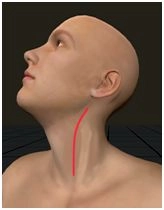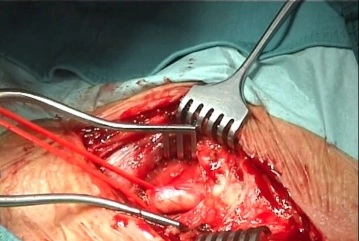Carry the longitudinal inciison along the anterior margin of the left sternocleidomastoid muscle. Divide the subcutaneous tissue and platysma, perform subtle hemostasis, ligature, and divide the lateral capsular vein of the thyroid gland.
-
Left cervical access
-
Dissecting the left common carotid artery
![Dissecting the left common carotid artery]()
Soundsettings Central exposure of the anterior aspect of the common carotid artery (CCA), which is then freed circumferentially; encircle it with a vessel loop as tourniquet. Continue the dissection cephalad mobilizing and medializing the cervical ansa. Dissect the facial vein and divide it between suture ligatures.
Tips:
1. Golden rule for dissection: Because of the risk of embolization, dissect the surrounding tissue off the CCA, not the other way around. The vessel should be handled as little as possible when dissecting.
2. The ansa cervicalis is the landmark leading straight to the hypoglossal nerve (CN XII). If dissection is approached differently, as in the video, problems will arise at the level of the internal carotid artery at the latest: The latter must then be subsequently medialized, which not only wastes time but also increases the risk of accidental injury to the hypoglossal nerve.
3. The facial vein should not be secured with simple ligatures, but always with suture ligatures. During emergence from anesthesia and also during coughing, the cervical veins are subjected to high pressures, which can cause simple ligatures to slip off, resulting in intense bleeding.
-
Dissecting the carotid bifurcation, mobilizing the hypoglossal nerve
![Dissecting the carotid bifurcation, mobilizing the hypoglossal nerve]()
Soundsettings Mobilize the hypoglossal nerve and ansa cervicalis by transecting between clips small, vascular branches tethering the nerve, and divide larger vessels between ligatures. Expose the external carotid artery (ECA) and isolate the superior thyroid artery. Encircle the ECA and expose the internal carotid artery (ICA) 1-2 cm above the calcification already visible from the outside. In the video, this requires divisdion of the occipital artery, as it tethers the hypoglossal nerve and thus blocks peripheral (= cephalad) access to the ICA.
Tips:
1. This step in the procedure requires that the cephalic angle of the wound be widened with blunt (carotid) retractors. Do not exert too much pressure as this could damage the oral branch of the facial nerve (postoperative angular drooping of the mouth).
2. Dissect only lateral to the ansa cervicalis. Medial dissection may impair hypoglossal nerve blood flow.
3. If enlarged lymph nodes are encountered during dissection, sweep these mediad en-bloc.
4. Here too, ensure: dissect perivascular tissue off the vessels, not the other way round.
5. Subtle sparing of vagus nerve! Usually, it is located “posteriad” between the ICA and internal jugular vein, but occasionally also more “anteriad” between the vessels. In arteriosclerotic perivascular adhesions, such as in the video, the extremely sensitive nerve must be carefully freed from the carotid artery so that it does not later get caught between the branches of the vascular clamps. Likewise, ensure that the carotid retractor does not catch the vagus nerve.
6. If extensive exposure of the ICA is required cephalad, the digastric muscle and occasionally the glossopharyngeal nerve (N. IX) will be encountered. This nerve must also be carefully spared, otherwise patients will suffer from extremely agonizing dyssynergia when swallowing.
7. If possible, do not encircle the hypoglossal nerve (N. XII), as this would require unnecessary circumferential dissection of it. Excessive devascularization and to-and-fro movement of the nerve may damage it (sequelae: muffled speech, patients biting their ipsilateral tongue when chewing). Instead of encircling, it may be temporarily sutured up to the mandibular musculature. Do this by solely grasping the perineurium and placing a loose suture ("air knot").
Administer 5000 IU of heparin systemically and wait for it to fully circulate, ventilate the patien
Activate now and continue learning straight away.
Single Access
Activation of this course for 3 days.
Most popular offer
webop - Savings Flex
Combine our learning modules flexibly and save up to 50%.
US$51.56/ yearly payment
vascular surgery
Unlock all courses in this module.
US$103.10 / yearly payment




